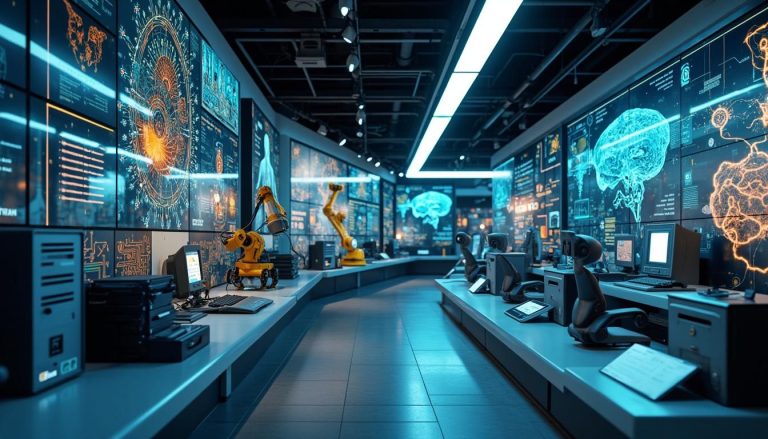The Impact of AI on the Transportation Industry
The transportation industry is undergoing a revolutionary transformation, driven by the rapid development and integration of Artificial Intelligence (AI). From autonomous vehicles to smart traffic management systems, AI is reshaping how we move people and goods. This blog post delves into the profound impact of AI on the transportation sector, exploring the benefits, challenges, and future trends.
Introduction to AI in Transportation
Artificial Intelligence has become a cornerstone of innovation in the transportation industry. According to a report by McKinsey, AI could potentially generate $400 billion in value annually for the sector by optimizing operations, improving safety, and enhancing the customer experience. But what exactly does AI bring to the table?
Understanding AI’s Role in Transportation
AI technologies, such as machine learning, computer vision, and natural language processing, are used to analyze vast amounts of data, make predictions, and automate decision-making processes. These capabilities are crucial for developing autonomous vehicles, optimizing logistics, and managing traffic flow.
Autonomous Vehicles: The Road to the Future
The most visible application of AI in transportation is the development of autonomous vehicles. Companies like Tesla, Waymo, and Uber are pioneering self-driving technology, promising safer and more efficient roads.
Enhancing Safety and Efficiency
AI-powered vehicles have the potential to significantly reduce accidents caused by human error, which accounts for 94% of all traffic incidents, according to the National Highway Traffic Safety Administration (NHTSA). By leveraging AI algorithms, these vehicles can detect obstacles, interpret traffic signals, and make split-second decisions to avoid collisions.
Redefining Mobility Services
Autonomous vehicles are also set to revolutionize mobility services. Ride-sharing companies are investing heavily in self-driving technology to offer cost-effective and on-demand transportation solutions. This shift is expected to reduce traffic congestion and lower emissions by optimizing ride-sharing routes.
AI in Logistics and Supply Chain Management
The integration of AI in logistics is transforming supply chain operations. AI-driven systems can predict demand patterns, optimize delivery routes, and enhance inventory management, ensuring goods are delivered efficiently and cost-effectively.
Optimizing Delivery Routes
AI algorithms analyze traffic data, weather conditions, and delivery time windows to determine the most efficient routes for delivery trucks. This optimization can reduce fuel consumption by up to 15%, as reported by a study from the Massachusetts Institute of Technology (MIT).
Improving Inventory Management
With AI, companies can forecast demand with greater accuracy, reducing overstock and stockouts. This capability minimizes storage costs and ensures that products are available when and where they are needed.
Smart Traffic Management Systems
Urban areas are increasingly adopting AI-powered traffic management systems to alleviate congestion and improve road safety. These systems use real-time data from sensors and cameras to monitor traffic flow and adjust traffic signals dynamically.
Reducing Traffic Congestion
AI systems analyze traffic patterns and predict congestion hotspots, allowing cities to implement proactive measures. For instance, adaptive traffic signal control can reduce stop-and-go traffic by 25%, according to a study by the U.S. Department of Transportation.
Enhancing Public Transportation
AI is also improving public transportation efficiency. Predictive analytics enable transit agencies to optimize bus and train schedules, reduce waiting times, and improve passenger satisfaction.
Challenges and Ethical Considerations
While AI offers numerous benefits, it also poses challenges and ethical dilemmas. Issues such as data privacy, cybersecurity, and job displacement need to be addressed to ensure responsible AI deployment in transportation.
Addressing Data Privacy Concerns
AI systems rely on vast amounts of data, raising concerns about user privacy. Implementing robust data protection measures and transparent data usage policies is essential to maintaining public trust.
Mitigating Job Displacement
The automation of certain transportation tasks may lead to job displacement. It is crucial to develop reskilling programs to prepare the workforce for new roles in the AI-driven economy.
Future Trends in AI and Transportation
The future of AI in transportation looks promising, with advancements in technology and increased adoption expected to drive further innovation.
Integration with IoT
The Internet of Things (IoT) will play a significant role in enhancing AI capabilities in transportation. Connected vehicles and infrastructure will enable real-time data exchange, facilitating more efficient and safer transportation systems.
Expansion of Autonomous Public Transport
Autonomous buses and shuttles are likely to become more prevalent, offering sustainable and accessible transportation options, particularly in urban environments.
Conclusion
AI is undeniably transforming the transportation industry, offering opportunities for improved safety, efficiency, and convenience. As technology continues to evolve, stakeholders must collaborate to address challenges and ensure that AI’s benefits are realized responsibly. By embracing AI, the transportation sector can pave the way for a smarter, more sustainable future.
To stay updated on the latest trends in AI and transportation, subscribe to our newsletter and join the conversation. Together, we can drive the future of mobility forward.

